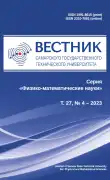Математическое моделирования зарождения солнечных пятен на фотосферном уровне Солнца
- Авторы: Романов Д.В.1, Романов К.В.1, Романов В.А.2, Степанов Е.А.2, Лебедев А.А.2
-
Учреждения:
- Красноярский государственный педагогический университет им. В. П. Астафьева
- Саратовский национальный исследовательский государственный университет им. Н. Г. Чернышевского
- Выпуск: Том 27, № 4 (2023)
- Страницы: 723-736
- Раздел: Математическое моделирование, численные методы и комплексы программ
- URL: https://journal-vniispk.ru/1991-8615/article/view/311001
- DOI: https://doi.org/10.14498/vsgtu2015
- EDN: https://elibrary.ru/JEEWMQ
- ID: 311001
Цитировать
Полный текст
Аннотация
Методом компьютерного моделирования исследуется начальная стадия зарождения группы солнечных пятен на фотосферном уровне Солнца. Численно моделируется процесс развития нелинейной фазы неустойчивости Паркера крупномасштабных колебаний магнитных полей в средних слоях конвективной зоны. Исследуется процесс адиабатического охлаждения тонкой магнитной трубки, всплывающей с глубин порядка 100 000 км к фотосферному уровню. Результаты расчетов позволяют детально проанализировать изменение магнитогазодинамических параметров трубки на различных глубинах конвективной зоны и получить значения физических параметров зарождающихся солнечных пятен, допускающих сопоставление с данными наблюдений.
Исследуется физический механизм временной задержки формирования головной части активной области по сравнению с формированием распыленной хвостовой части. Также исследуется проблема устойчивости зарождающихся активных областей. Выделены физические параметры, определяющие устойчивость сформированных активных областей на различных фазах цикла солнечной активности. Определен физический механизм генерации мощного волнового потока ударных волн в начальной стадии зарождения активной области, вносящий существенный вклад в аномальный разогрев солнечной атмосферы, регистрируемый в наблюдательных данных.
Ключевые слова
Полный текст
Открыть статью на сайте журналаОб авторах
Дмитрий Валерьевич Романов
Красноярский государственный педагогический университет им. В. П. Астафьева
Автор, ответственный за переписку.
Email: d-v-romanov@ya.ru
ORCID iD: 0000-0002-4982-5973
https://www.mathnet.ru/person183792
кандидат физико-математических наук; доцент; каф. информатики и информационных технологий в образовании
Россия, 660049, Красноярск, ул. Ады Лебедевой, 89Константин Валерьевич Романов
Красноярский государственный педагогический университет им. В. П. Астафьева
Email: k-v-romanov@ya.ru
ORCID iD: 0000-0001-7320-2517
https://www.mathnet.ru/person183791
кандидат физико-математических наук; доцент; каф. математики и методики обучения математике
Россия, 660049, Красноярск, ул. Ады Лебедевой, 89Валерий Александрович Романов
Саратовский национальный исследовательский государственный университет им. Н. Г. Чернышевского
Email: valeriy.a.romanov@yandex.ru
ORCID iD: 0000-0001-9876-0822
https://www.mathnet.ru/person183794
доктор физико-математических наук; профессор; каф. математической кибернетики и компьютерных наук
Россия, 410012, Саратов, ул. Астраханская, 83Евгений Александрович Степанов
Саратовский национальный исследовательский государственный университет им. Н. Г. Чернышевского
Email: ev_stepanof@yandex.ru
ORCID iD: 0000-0002-2050-2724
https://www.mathnet.ru/person203707
аспирант; каф. математической кибернетики и компьютерных наук
Россия, 410012, Саратов, ул. Астраханская, 83Антон Андреевич Лебедев
Саратовский национальный исследовательский государственный университет им. Н. Г. Чернышевского
Email: anon20016@gmail.com
ORCID iD: 0000-0002-8241-1916
https://www.mathnet.ru/person203708
аспирант; каф. математической кибернетики и компьютерных наук
Россия, 410012, Саратов, ул. Астраханская, 83Список литературы
- Bray R. J., Loughhead R. E. Sunspots. New York: Dover Publ., 1979. 303 pp.
- Обридко В. Н. Солнечные пятна и комплексы активности. М.: Наука, 1985. 255 с.
- Tlatov A. G. Lifetime of sunspots and pores // Sol. Phys., 2023. vol. 298, 93. DOI: https://doi.org/10.1007/s11207-023-02186-7.
- Parker E. N. Cosmical Magnetic Fields. Their Origin and their Activity / The International Series of Monographs on Physics. Oxford: Clarendon Press, 1979. xvii+841 pp.
- Tlatov A. G. Dark dots on the photosphere and their counting in the sunspot index // Sol. Phys., 2022. vol. 297, 67, arXiv: 2205.13142 [astro-ph.SR]. DOI: https://doi.org/10.1007/s11207-022-02002-8.
- Alissandrakis C. E., Vial J-C. Explosive events in the quiet Sun near and beyond the solar limb observed with the Interface Region Imaging Spectrograph (IRIS) // Sol. Phys., 2023. vol. 298, 18, arXiv: 2301.07190 [astro-ph.SR]. DOI: https://doi.org/10.1007/s11207-023-02111-y.
- Григорьев В. М., Ермакова Л. В., Хлыстова А. И. Появление магнитного потока на солнечной поверхности и рождение активных областей // Астрон. ж., 2009. Т. 86, №9. С. 935–944. EDN: KWICRF.
- Alekseenko S. V., Dudnikova G. I., Romanov V. A., et al. Magnetic field instabilities in the solar convective zone // Rus. J. Eng. Thermophys., 2000. vol. 10. pp. 243–262.
- Spruit H. C., Zweibel E. G. Convective instability of thin flux tubes // Sol. Phys., 1979. vol. 62, no. 1. pp. 15–22. EDN: BKMUKO. DOI: https://doi.org/10.1007/BF00150128.
- Ruderman M. S., Petrukhin N. S. Nonlinear generation of fluting perturbations by kink mode in a twisted magnetic tube // Sol. Phys., 2022. vol. 297, no. 9, 116. EDN: ASYPRH. DOI: https://doi.org/10.1007/s11207-022-02054-w.
- Christensen–Dalsgaard J., Däppen W., Ajukov S. V., et al. The current state of Solar modeling // Science, 1996. vol. 272, no. 5266. pp. 1286–1292. DOI: https://doi.org/10.1126/science.272.5266.1286.
- Parker E. N. Theoretical properties of Omega-loops in the convective zone of the Sun. 1: Emerging bipolar magnetic regions // Astrophys. J., 1994. vol. 433. pp. 867–874. DOI: https://doi.org/10.1086/174695.
- Степанов Е. А., Майоров А. О., Романов К. В. [и др.] Математическое моделирование развития неустойчивости Паркера крупномасштабных колебаний магнитных полей в конвективной зоне Солнца // Изв. Сарат. ун-та. Нов. cер. Сер. Физика, 2021. Т. 21, №2. С. 106–115. EDN: DZYYVB. DOI: https://doi.org/10.18500/1817-3020-2021-21-2-106-115.
- Zurbriggen E., Cécere M., Sieyra M. V., et al. An MHD study of large-amplitude oscillations in Solar filaments // Sol. Phys., 2021. vol. 296, 173, arXiv: 2110.07687 [astro-ph.SR]. DOI: https://doi.org/10.1007/s11207-021-01908-z.
- Hamada A., Asikainen T., Mursula K. New homogeneous dataset of Solar EUV synoptic maps from SOHO/EIT and SDO/AIA // Sol. Phys., 2019. vol. 295, no. 1, 2. EDN: BVEEJG. DOI: https://doi.org/10.1007/s11207-019-1563-y.
Дополнительные файлы














